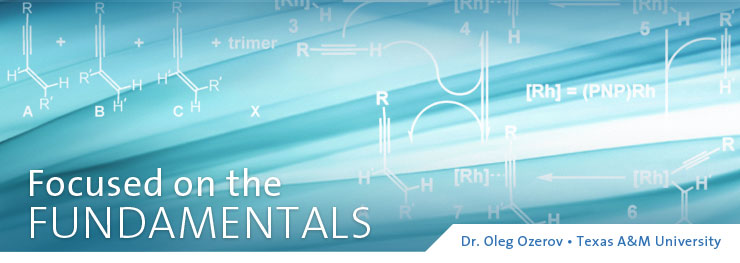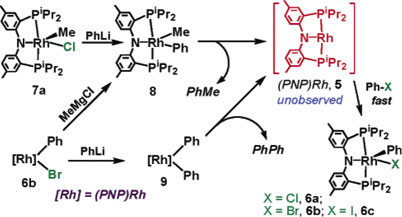


| Transition Metal Complexes of PNP Ligands |
For Dr. Oleg Ozerov, the allure of inorganic chemistry lies in the possibility of creating something that has never existed before. "As a chemist you create your own subject," he explains. "You can make a certain molecule that had not existed in the world before. It's philosophically kind of cool."
Ozerov, a professor of chemistry at Texas A&M University, subscribes to a three-pronged research goal. First, he strives to discover new, unusual chemical structures. Second, he studies elementary chemical reactions for inspiration. Finally, he applies these fundamental approaches to the field of catalysis, to design materials that help make chemical reactions faster and more efficient.

Figure taken from Dr. Ozerov's research (© 2009 American Chemical Society)
Much of his research focuses on PNP ligands, which are ligands with three points of attachment to a metal center, bonded with a phosphorus, nitrogen, and phosphorus (P-N-P). One unique feature of a PNP ligand, according to Ozerov, is that it happens, by good fortune, to bind quite successfully to a number of elements in the periodic table. Another interesting feature is its rigid geometry. The phosphorus, nitrogen, and phosphorus are almost always on the same plane as the metal center, forming a T-shaped array. The benefit of the rigidity, Ozerov says, is that it reduces the complexity of what may or may not happen at the metal center. It becomes easier to understand reactions because there aren't as many possibilities to consider.
Ozerov hopes that the fundamental chemistry he is attempting to uncover might one day be instrumental to solving a plethora of global energy challenges. His explorations serve as building blocks for other topics of investigation, including solar energy conversion. "We do use ideas garnered ultimately from our PNP work and ligand design. We learn from it and evolve." He adds, "ACS PRF is wise to fund this fundamental research. Transition metal chemistry, in particular, is bound to serve a critical role."
Read more about Dr. Ozerov's topic, Rigid Pincer Ligands: New Prospects in Hypercoordinate Main Group Chemistry.

Dr. Ozerov (third from left) with his students